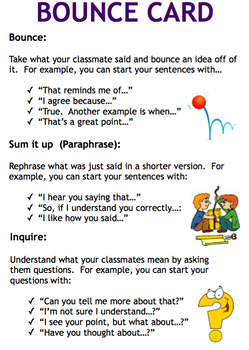Bounce Cards
What It Is
Bounce cards are a way to help students who struggle to get academic conversations started. They give students, especially those who are more reserved, something to say.
How It Works
1. Select a student to practice modeling a conversation with you for the class to observe. Practice with that student before modeling to the class.
2. Model the “wrong way” to hold a conversation. For example, demonstrate a conversation that ends quickly once both parties have shared their response, with no back-and-forth dialogue between the two parties. Discuss the importance of conversational skills that allow ideas to bounce from one person to the next.
3. Discuss the following three approaches to responding to peers’ comments:
- Bounce: Take what your classmate said and bounce an idea off it (or extend the idea. For example, you can start your sentences with:
- “That reminds me of…”
- “I agree, because…”
- “True. Another example is when…”
- “That’s a great point…”
- Sum it up: Rephrase what was just said in a shorter version. For example, you can start your sentences with:
- “I hear you saying that…”
- “So, if I understand you correctly…”
- “I like how you said…”
- Ask a question: Understand what your classmates mean by asking them questions. For example, you can start your sentences with:
- “Can you tell me more about that?”
- “I’m not sure I understand…”
- “I see your point, but what about…?”
- “Have you thought about…”
4. Model a conversation using the Bounce Card Sentence Starters.
5. Allow the students to practice using prepare topics or prompts.
Ask all students to try the Bounce Cards at the same time, so that no one group of students is embarrassed about trying it out. Let students know that conversations won’t sound natural at first, but the goal is to get so comfortable bouncing ideas off each other that they will be able to do so without any prompts. Create a large poster of the Bounce Card so that all students can refer to the chart without needing to take out their Bounce Cards.
How to Ensure Higher-Order Thinking
The Bounce Cards provide an opportunity to focus on an important everyday life skill that even many adults are still in the process of developing. Ask students to think about the relevance of developing these conversational skills for their everyday lives. Ask them to try these skills out at home or with friends. If we can get students comfortable with the art of conversation, it will have the potential of not only building community within our classrooms but also allowing for deeper extended conversations regarding the content that we teach.

Source
Himmele P., and Himmele, W. Total Participation Techniques: Making Every Student an Active Learner. ASCD, 2017, pp.80-82.